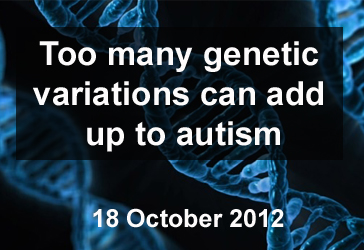Check out other stories from the Latest News
Research Supports Additive Model of ASD Risk
By Stacy W. Kish on October 18, 2012

Background: Autism Spectrum Disorder (ASD) is defined by impaired social interaction and communication, as well as repetitive behaviors. With new technologies developed during the past decade, scientists began looking for genetic variations to explain ASD.
What’s new: This study examined the genomes of 2,700 families with one (simplex) or several (multiplex) autistic children. The researchers used statistical models to determine the risk of autism resulting from the contribution of both common and rare genetic variations known as single nucleotide polymorphisms (SNPs). The results suggest that a delicate interplay occurs between the additive effect of many common variants and the risk of autism, dubbed the Additive model of ASD risk. For currently unknown reasons, simplex families follow the additive model more closely than multiplex families.
Why it’s important: This work contributes to the long-standing question in the scientific community on the extent of genetic contribution to ASD. Future studies may further define the involvement of common and rare genetic variations in the risk of autism. In addition, this work may contribute to the development of diagnostic tests in the future to assess an individual’s risk of developing autism.
Help me understand :
| Source(s) : |
| Tweet |

